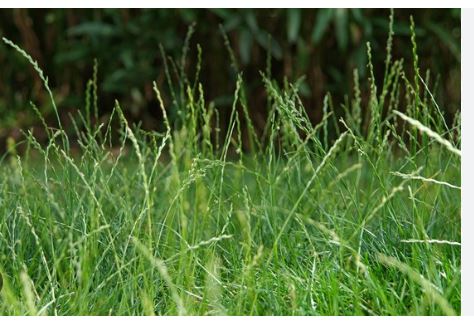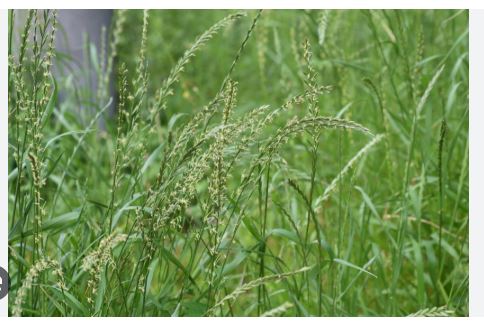
Ryegrass (Lolium spp.), a cool-season grass in the Poaceae family, hails from Europe, Asia, and North Africa, thriving in temperate climates (Zones 5–9). Known for rapid germination (5–10 days) and lush growth, it forms dense bunches or, in some hybrids, spreads via stolons. It’s a staple for lawns, pastures, and erosion control, with annual and perennial forms.
Two primary species dominate: Lolium multiflorum (annual/Italian ryegrass), fast-growing and forage-focused, and Lolium perenne (perennial ryegrass), finer and turf-oriented. Blades range from 1.5–8 mm wide, colors from light to dark green, and heights from 6 inches to 4 feet unmowed. Hybrids blend traits for versatility.
It grows best in spring and fall (50°F–75°F), on well-drained, fertile soils (pH 6.0–7.0), seeded at 6–30 lbs/acre or sodded. Full sun is ideal, though some tolerate light shade; water needs are 1–2 inches weekly, and nitrogen ranges 80–150 lbs/acre annually. Establishment takes 4–12 months, depending on type and method.
Ryegrass excels in wear tolerance, quick cover, and high yields (3–10 tons DM/acre), with annuals favoring forage (15–25% CP) and perennials suiting lawns or sports fields. Mow at 0.5–2 inches for turf, 4–12 inches for grazing; its vigor requires rust and thatch management, especially in wet conditions.
Its adaptability shines in overseeding warm-season turfs, temporary lawns, or permanent pastures, though heat above 85°F and drought stress it. Annuals die off in summer, while perennials persist 2–5 years with care. From rough forage to manicured greens, ryegrass balances speed, beauty, and utility.

Types of Ryegrass
Marshall Ryegrass (Lolium multiflorum ‘Marshall’)
Marshall is an annual ryegrass cultivar with medium-wide blades (4–6 mm), a glossy, bright green color, and a bunch-type growth reaching 2–3 feet unmowed. Selected in Mississippi (1980s) for cold tolerance, it suits Zones 6–9 (-10°F–20°F), maturing in 6–8 months on fertile, well-drained soil (pH 6.0–7.0). It germinates in 7–10 days, spreads 1–2 feet laterally via tillers, and yields 6–8 tons DM/acre with irrigation. Mow or graze at 6–10 inches; its high sugar content (15–20% DM) boosts digestibility (70% TDN). Used for winter forage, cover crops, or overseeding, it needs 1–2 inches water weekly and 100–150 lbs nitrogen/acre. Rust-prone in humid springs.
Gulf Annual Ryegrass (Lolium multiflorum ‘Gulf’)
Gulf, an early annual cultivar from the Gulf Coast (1950s), has coarse blades (5–7 mm), a lighter green hue, and a vigorous, upright form (2–3 feet). Hardy to Zone 7 (0°F), it grows fast (germination 5–7 days) on varied soils (pH 5.5–7.0), establishing in 4–6 weeks from seed (20–30 lbs/acre). Mow at 1.5–2 inches for turf or graze at 8–12 inches for forage; it yields 5–7 tons DM/acre. Ideal for erosion control or winter lawns in the South, it tolerates wet soils but fades in summer heat (above 90°F). Needs 100–120 lbs nitrogen/acre; disease resistance is moderate.
TAM 90 Ryegrass (Lolium multiflorum ‘TAM 90’)
TAM 90, a Texas A&M annual (1990s), features medium blades (3–5 mm), a dark green color, and a dense, bunching habit (2–3 feet). Suited to Zones 6–9, it offers improved heat tolerance, thriving in full sun on loamy soils (pH 6.0–6.5). Germinates in 7–10 days, spreads 1–1.5 feet/year, and matures in 6–8 months, yielding 7–9 tons DM/acre with 150 lbs nitrogen/acre. Mow at 1–2 inches for turf or graze at 6–10 inches; its 18% crude protein suits dairy grazing. Drought-tolerant for an annual, it needs 1 inch water weekly and resists rust better than Gulf.
Westerwold Ryegrass (Lolium multiflorum var. westerwoldicum)
Westerwold, a true annual subtype from the Netherlands (1930s), has coarse blades (5–8 mm), a medium-green hue, and an upright, heading habit (3–4 feet). Adapted to Zones 6–10, it grows fast (5–7 days germination) on fertile soils (pH 6.0–7.0), producing seed in its first year without vernalization. Yields 6–8 tons DM/acre, mow or graze at 8–12 inches; its rapid cycle suits short-term forage or cover crops. Needs 1–2 inches water weekly and 100–150 lbs nitrogen/acre. Heat-tolerant but cold-sensitive below 10°F; rust and weediness are concerns.
Italian Ryegrass (Lolium multiflorum)
Italian Ryegrass, the species baseline, has glossy, medium-wide blades (4–6 mm), a bright green color, and a bunching form (2–3 feet). Native to southern Europe, it acts as a biennial in mild climates (Zones 6–9), persisting 1–2 years. Germinates in 7–10 days, spreads 1–2 feet/year, and thrives on moist, fertile soils (pH 6.0–6.5), yielding 7–10 tons DM/acre. Mow at 1–2 inches for turf or graze at 6–12 inches; its 16–20% CP and 65–70% TDN make it a top forage. Needs 1 inch water weekly and 120–150 lbs nitrogen/acre; prone to rust and seedhead drop.
Tetrone Ryegrass (Lolium multiflorum ‘Tetrone’)
Tetrone, a tetraploid annual (four chromosome sets), has wide blades (6–8 mm), a dark green color, and a robust, upright habit (3–4 feet). Bred for higher sugars (20–25% DM), it suits Zones 6–9, growing on rich soils (pH 6.0–7.0). Germinates in 7–10 days, spreads 1–1.5 feet/year, and yields 8–10 tons DM/acre with 150 lbs nitrogen/acre. Mow or graze at 8–12 inches; its palatability boosts livestock intake. Needs 1–2 inches water weekly; heat-tolerant but less persistent than diploids, it’s prone to large patch in wet springs.
BG-34 Ryegrass (Lolium perenne ‘BG-34’)
BG-34, a perennial cultivar, features fine blades (2–3 mm), a dark green hue, and a dense, low growth (6–12 inches unmowed). Hardy to Zone 5 (-20°F), it thrives in full sun to light shade on loamy soils (pH 6.0–6.5), establishing in 6–12 months from seed (6–10 lbs/acre). Mow at 1–2 inches for turf or graze at 4–8 inches; it yields 4–6 tons DM/acre annually. Cold and wear-tolerant, it needs 1 inch water weekly and 80–120 lbs nitrogen/acre. Ideal for permanent pastures or lawns, it resists rust but builds thatch.
Linn Ryegrass (Lolium perenne ‘Linn’)
Linn, an early perennial cultivar from Oregon (1960s), has medium blades (3–4 mm), a medium-green color, and a bunching habit (8–14 inches unmowed). Suited to Zones 5–8, it grows in full sun on varied soils (pH 5.5–7.0), maturing in 6–12 months from seed. Mow at 1–2 inches for turf; it offers moderate yields (3–5 tons DM/acre) with 80–100 lbs nitrogen/acre. Known for quick germination (5–7 days), it’s used in lawns and pastures, tolerating moderate shade but fading in heat above 85°F. Rust resistance is average.
Manhattan Ryegrass (Lolium perenne ‘Manhattan’)
Manhattan, a turf-type perennial (1970s), has fine blades (1.5–2.5 mm), a dark green color, and a dense, low profile (6–10 inches unmowed). Hardy to Zone 5, it excels in full sun on well-drained soils (pH 6.0–6.5), establishing in 6–12 months from seed (8–12 lbs/acre). Mow at 0.5–1.5 inches with a reel mower; its wear tolerance suits sports fields and lawns. Yields 3–4 tons DM/acre with 80–120 lbs nitrogen/acre; it needs 1 inch water weekly. Heat and drought tolerance are improved over older types, though thatch is a concern.
Barenbrug RPR Ryegrass (Lolium perenne ‘RPR’)
RPR (Regenerating Perennial Ryegrass), a Barenbrug innovation, has fine blades (2–3 mm), a dark green hue, and a unique stoloniferous habit (spreads laterally), reaching 6–12 inches unmowed. Hardy to Zone 5, it grows in full sun to light shade on loamy soils (pH 6.0–6.5), establishing in 6–12 months from seed. Mow at 1–2 inches; its self-repairing nature suits high-traffic turf, yielding 4–6 tons DM/acre with 100–120 lbs nitrogen/acre. Needs 1 inch water weekly; it resists wear and diseases like gray leaf spot.
Calibra Ryegrass (Lolium perenne ‘Calibra’)
Calibra, a tetraploid perennial, features wider blades (4–6 mm), a rich green color, and a dense, upright form (8–14 inches unmowed). Suited to Zones 5–8, it thrives in full sun on fertile soils (pH 6.0–6.5), maturing in 6–12 months from sod or seed. Mow or graze at 4–8 inches; its 18–22% CP and high sugars (20% DM) make it a premium forage, yielding 5–7 tons DM/acre with 100–150 lbs nitrogen/acre. Needs 1 inch water weekly; cold-tolerant but less heat-resistant, it’s prone to rust in humid conditions.
Bastion Ryegrass (Lolium perenne ‘Bastion’)
Bastion, a tetraploid perennial (Netherlands), has broad blades (5–7 mm), a dark green color, and a robust, bunching habit (10–16 inches unmowed). Hardy to Zone 5, it grows in full sun to partial shade on rich soils (pH 6.0–7.0), establishing in 6–12 months. Mow or graze at 4–8 inches; it yields 5–8 tons DM/acre with 120–150 lbs nitrogen/acre, offering high palatability. Needs 1–2 inches water weekly; its late heading (mid-May) extends quality forage. Cold and shade-tolerant, it resists pests but builds thatch.
Attain Ryegrass (Lolium perenne ‘Attain’)
Attain, a turf-type perennial, has fine blades (1.5–2 mm), a deep green hue, and a tight, low growth (6–10 inches unmowed). Suited to Zones 5–9, it thrives in full sun on well-drained soils (pH 6.0–6.5), maturing in 6–12 months from seed (8–12 lbs/acre). Mow at 0.5–1.5 inches; its density suits lawns and fairways, with moderate yields (3–5 tons DM/acre). Needs 1 inch water weekly and 80–100 lbs nitrogen/acre; heat and wear-tolerant, it resists gray leaf spot but requires dethatching.
Tetrastar Ryegrass (Lolium multiflorum ‘Tetrastar’)
Tetrastar, a tetraploid annual, features wide blades (6–8 mm), a bright green color, and an upright, vigorous form (3–4 feet). Adapted to Zones 6–9, it grows fast (7–10 days germination) on fertile soils (pH 6.0–6.5), yielding 8–10 tons DM/acre in 6–8 months with 150 lbs nitrogen/acre. Mow or graze at 8–12 inches; its high sugars (20–25% DM) enhance livestock gains. Needs 1–2 inches water weekly; heat-tolerant but short-lived, it’s prone to rust and weediness if not managed.
Bison Ryegrass (Hybrid: Lolium multiflorum × Lolium perenne)
Bison, a short-rotation hybrid, has medium blades (3–5 mm), a medium-green hue, and a dense, upright habit (2–3 feet). Suited to Zones 6–8, it persists 1–3 years on loamy soils (pH 6.0–6.5), maturing in 6–12 months from seed. Mow or graze at 6–10 inches; it yields 6–8 tons DM/acre with 100–120 lbs nitrogen/acre, blending annual vigor with perennial persistence. Needs 1 inch water weekly; it tolerates moderate shade but succumbs to heat above 90°F. Rust resistance is moderate.
Darnel Ryegrass (Lolium temulentum)
Darnel, a wild annual or biennial, has narrow blades (2–4 mm), a dull green color, and a sparse, upright form (1–3 feet). Found in Zones 5–9, it grows on disturbed soils (pH 5.5–7.0), germinating in 7–14 days and self-seeding aggressively. Rarely mowed (3–6 inches), it’s a weed, not a crop, often hosting toxic Neotyphodium fungi, posing risks to livestock. Yields are low (1–3 tons DM/acre); it needs minimal water and nutrients. Historically a grain field contaminant, it’s now a noxious invader.